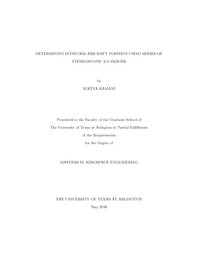
ATTENTION: The works hosted here are being migrated to a new repository that will consolidate resources, improve discoverability, and better show UTA's research impact on the global community. We will update authors as the migration progresses. Please see MavMatrix for more information.
Show simple item record
| dc.contributor.advisor | Dogan, Atilla | |
| dc.creator | Ramani, Aditya | |
| dc.date.accessioned | 2016-07-22T17:35:46Z | |
| dc.date.available | 2016-07-22T17:35:46Z | |
| dc.date.created | 2016-05 | |
| dc.date.issued | 2016-05-10 | |
| dc.date.submitted | May 2016 | |
| dc.identifier.uri | http://hdl.handle.net/10106/25822 | |
| dc.description.abstract | Introduction of UAV (Unmanned Aerial Vehicles) into the NAS (National Air
Space) requires the detect-and-avoid capability. That is, an aircraft should be able to detect other aircraft flying in the same airspace volume and make evasive maneuvers if there is potential conflict. One potential methods currently investigated for detection
of an intruder aircraft is to process digital images taken by onboard cameras. When and if intruder aircraft detection is successful through image processing, avoidance algorithms can greatly benefit from the relative position information. This thesis
research investigates methods to compute the position of an intruder aircraft relative to an observer aircraft with onboard stereo cameras. To focus on relative position estimation rather than the intruder aircraft detection through image processing, the first phase of the research effort was to generate camera images given the relative position information. This process uses a simple pinhole camera methods where cameras are characterized by focal length, angle of view and resolution. The second
phase of the research developed two methods to estimate the relative position based on the generated camera images. Both methods employ epipolar geometry of stereo vision based on two cameras placed on the aircraft with lateral separation. Various
cases are run in a Matlab/Simulink-simulation environment that is developed for this research. Simulation cases are designed to evaluate the relative position estimation methods with different aircraft trajectories, different camera separation, and different camera resolution. Simulation results show that relative position can be estimated while both aircraft are
flying along any trajectories as long as the intruder aircraft is visible by both cameras. The estimation accuracy degrades as the relative distance
increases between the aircraft. The larger lateral separation seems to improve the estimation accuracy. Image resolution seems to have little to no impact on estimation
accuracy. | |
| dc.format.mimetype | application/pdf | |
| dc.subject | Relative Position | |
| dc.subject | Stereoscopic Images | |
| dc.title | DETERMINING INTRUDER AIRCRAFT POSITION USING SERIES OF STEREOSCOPIC 2-D IMAGES | |
| dc.type | Thesis | |
| dc.degree.department | Mechanical and Aerospace Engineering | |
| dc.degree.name | Master of Science in Aerospace Engineering | |
| dc.date.updated | 2016-07-22T17:35:46Z | |
| thesis.degree.department | Mechanical and Aerospace Engineering | |
| thesis.degree.grantor | The University of Texas at Arlington | |
| thesis.degree.level | Masters | |
| thesis.degree.name | Master of Science in Aerospace Engineering | |
| dc.type.material | text | |
Files in this item
- Name:
- RAMANI-THESIS-2016.pdf
- Size:
- 1.567Mb
- Format:
- PDF
This item appears in the following Collection(s)
Show simple item record


